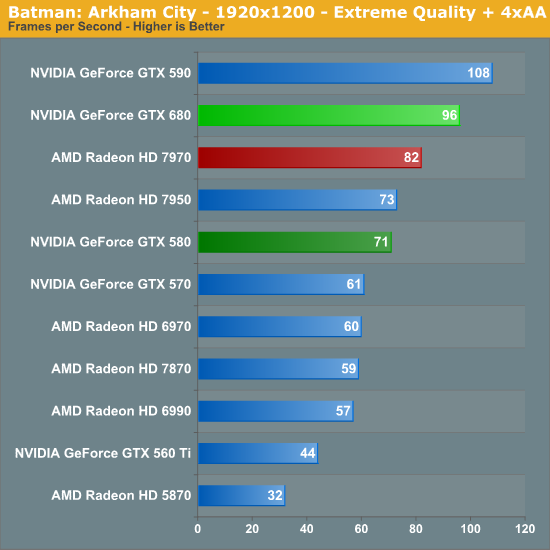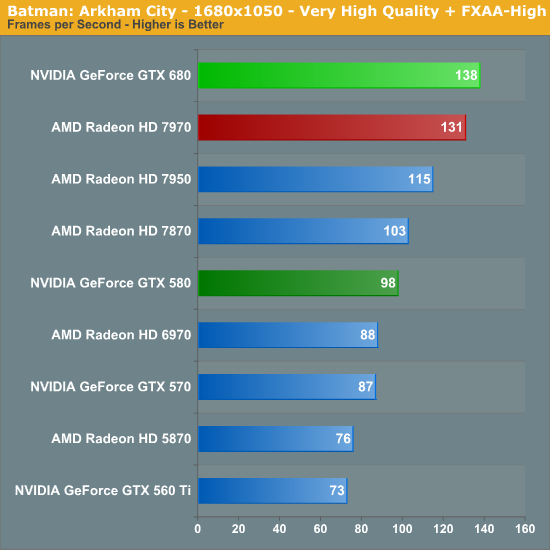NVIDIA GeForce GTX 680 Review: Retaking The Performance Crown
by Ryan Smith on March 22, 2012 9:00 AM ESTBatman: Arkham City
Batman: Arkham City is loosely based on Unreal Engine 3, while the DirectX 11 functionality was apparently developed in-house. With the addition of these features Batman is far more a GPU demanding game than its predecessor was, particularly with tessellation cranked up to high.



Once again the GTX 680 takes a respectable lead over the 7970, this time beating AMD’s top card by 13% at 2560, and coming very close to cracking 60fps here. The performance gains over the GTX 580 are also solid, with the GTX 680 leading by 34% or better.










404 Comments
View All Comments
Slayer68 - Saturday, March 24, 2012 - link
Being able to run 3 screens off of one card is new for Nvidia. Barely even mentioned it in your review. It would be nice to see Nvidia surround / Eyefinity compared on these new cards. Especially interested in scaling at 5760 x 1080 between a 680 and 7970.....ati666 - Saturday, March 24, 2012 - link
does the gtx680 still have the same anisotropic filtering pattern like the gtx470/480/570/580 (octagonal pattern) or is it like AMDs HD7970 all angle-independent anisotropic filtering (circular pattern)?Ryan Smith - Saturday, March 24, 2012 - link
It's not something we were planning on publishing, but it is something we checked. It's still the same octagon pattern as Fermi. It would be nice if NVIDIA did have angle-independent AF, but to be honest the difference between that and what NVIDIA does has been so minor that it's not something we've ever been able to create a noticeable issue with in the real world.Now Intel's AF on the other hand...
ati666 - Saturday, March 24, 2012 - link
thank for the reply, now i can finally make a decision to buy hd7970 or gtx680..CeriseCogburn - Saturday, March 24, 2012 - link
Yes I thank him too for finally coming clean and noting the angle independent amd algorithm he's been fanboy over for a long time has absolutely no real world gaming advantage whatsoever.It's a big fat zero of nothing but FUD for fanboys.
It would be nice if notional advantages actually showed up in games, and when they don't or for the life of the reviewer cannot be detected in games, that be clearly stated and the insane "advantage" declared be called what it really is, a useless talking point of deception that fools purchasers instead of enlightening them.
The biased emphasis with zero advantage is as unscientific as it gets. Worse yet, within the same area, the "perfectly round algorithm" yielded in game transition lines with the amd cards, denied by the reviewer for what, a year ? Then a race game finally convinced him, and in this 7000 series release we find another issue the "perfectly round algorithm" apparently was attached to flaw with, a "poor transition resolution" - rather crudely large instead of fine like Nvidia's which casued excessive amd shimmering in game, and we are treated to that information only now after the 7000 series "solved" the issue and brought it near or up to the GTX long time standard.
So this whole "perfectly round algorithm" has been nothing but fanboy lies for amd all along, while ignoring at least 2 large IQ issues when it was "put to use" in game. (transition shading and shimmering)
I'm certain an explanation could be given that there are other factors with differing descriptive explanation, like the fineness of textural changes as one goes toward center of the image not directly affecting roundness one way or another, used as an excuse, perhaps the self deceptive justification that allowed such misbehavior to go on for so long.
_vor_ - Saturday, March 24, 2012 - link
Will you seriously STFU already? It's hard to read this discussion with your blatant and belligerent jackassery all over it.You love NVIDIA. Great. Now STFU and stop posting.
CeriseCogburn - Saturday, March 24, 2012 - link
Great attack, did I get anything wrong at all ? I guess not.silverblue - Monday, March 26, 2012 - link
Could you provide a link to an article based on this subject, please? Not an attack; just curious.CeriseCogburn - Tuesday, March 27, 2012 - link
http://www.anandtech.com/show/5261/amd-radeon-hd-7...http://forums.anandtech.com/showpost.php?p=3152067...
" So what then is going on that made Civ V so much faster for NVIDIA? Admittedly I had to press NVIDIA for this - performance practically doubled on high-end GPUs, which is unheard of. Until they told me what exactly they did, I wasn't convinced it was real or if they had come up with a really sweet cheat. It definitely wasn't a cheat.
If you recall from our articles, I keep pointing to how we seem to be CPU limited at the time. "
(YES, SO THAT'S WHAT WE GOT, THEY'RE CHEATING IT'S FAKE WE'RE CPU LIMITED- ALL WRONG ALL LIES)
Since AMD’s latest changes are focused on reducing shimmering in motion we’ve put together a short video of the 3D Center Filter Tester running the tunnel test with the 7970, the 6970, and GTX 580. The tunnel test makes the differences between the 7970 and 6970 readily apparent, and at this point both the 7970 and GTX 580 have similarly low levels of shimmering.
with both implementing DX9 SSAA with the previous generation of GPUs, and AMD catching up to NVIDIA by implementing Enhanced Quality AA (their version of NVIDIA’s CSAA) with Cayman. Between Fermi and Cayman the only stark differences are that AMD offers their global faux-AA MLAA filter, while NVIDIA has support for true transparency and super sample anti-aliasing on DX10+ games.
(AMD FINALLY CATCHES UP IN EQAA PART, NVIDIA TRUE STANS AND SUPER SAMPLE HIGH Q STUFF, AMD CHEAT AND BLUR AND BLUR TEXT)
Thus I had expected AMD to close the gap from their end with Southern Islands by implementing DX10+ versions of Adaptive AA and SSAA, but this has not come to pass.
( AS I INTERPRETED AMD IS WAY BEHIND STILL A GAP TO CLOSE ! )
AMD has not implemented any new AA modes compared to Cayman, and as a result AAA and SSAA continue to only available in DX9 titles.
Finally, while AMD may be taking a break when it comes to anti-aliasing they’re still hard at work on tessellation
( BECAUSE THEY'RE BEHIND IN TESSELLATION TOO.)
Don't forget amd has a tessellation cheat in their 7000 series driver, so 3dmark 11 is cheated on as is unigine heaven, while Nvidia does no such thing.
---
I do have more like the race car game admission, but I think that's enough helping you doing homework .
CeriseCogburn - Tuesday, March 27, 2012 - link
So here's more mr curious .." “There’s nowhere left to go for quality beyond angle-independent filtering at the moment.”
With the launch of the 5800 series last year, I had high praise for AMD’s anisotropic filtering. AMD brought truly angle-independent filtering to gaming (and are still the only game in town), putting an end to angle-dependent deficiencies and especially AMD’s poor AF on the 4800 series. At both the 5800 series launch and the GTX 480 launch, I’ve said that I’ve been unable to find a meaningful difference or deficiency in AMD’s filtering quality, and NVIDIA was only deficienct by being not quite angle-independent. I have held – and continued to hold until last week – the opinion that there’s no practical difference between the two.
It turns out I was wrong. Whoops.
The same week as when I went down to Los Angeles for AMD’s 6800 series press event, a reader sent me a link to a couple of forum topics discussing AF quality. While I still think most of the differences are superficial, there was one shot comparing AMD and NVIDIA that caught my attention: Trackmania."
" The shot clearly shows a transition between mipmaps on the road, something filtering is supposed to resolve. In this case it’s not a superficial difference; it’s very noticeable and very annoying.
AMD appears to agree with everyone else. As it turns out their texture mapping units on the 5000 series really do have an issue with texture filtering, specifically when it comes to “noisy” textures with complex regular patterns. AMD’s texture filtering algorithm was stumbling here and not properly blending the transitions between the mipmaps of these textures, resulting in the kind of visible transitions that we saw in the above Trackmania screenshot. "
http://www.anandtech.com/show/3987/amds-radeon-687...
WE GET THIS AFTER 6000 SERIES AMD IS RELEASED, AND DENIAL UNTIL, NOW WE GET THE SAME THING ONCE 7000 SERIES IS RELEASED, AND COMPLETE DENIAL BEFORE THAT...
HERE'S THE 600 SERIES COVERUP THAT COVERS UP 5000 SERIES AFTER ADMITTING THE PROBLEM A WHOLE GENERATION LATE
" So for the 6800 series, AMD has refined their texture filtering algorithm to better handle this case. Highly regular textures are now filtered properly so that there’s no longer a visible transition between them. As was the case when AMD added angle-independent filtering we can’t test the performance impact of this since we don’t have the ability to enable/disable this new filtering algorithm, but it should be free or close to it. In any case it doesn’t compromise AMD’s existing filtering features, and goes hand-in-hand with their existing angle-independent filtering."
NOW DON'T FORGET RYAN HAS JUST ADMITTED AMD ANGLE INDEPENDENT ALGORITHM IS WORTH NOTHING IN REAL GAME- ABSOLUTELY NOTHING.